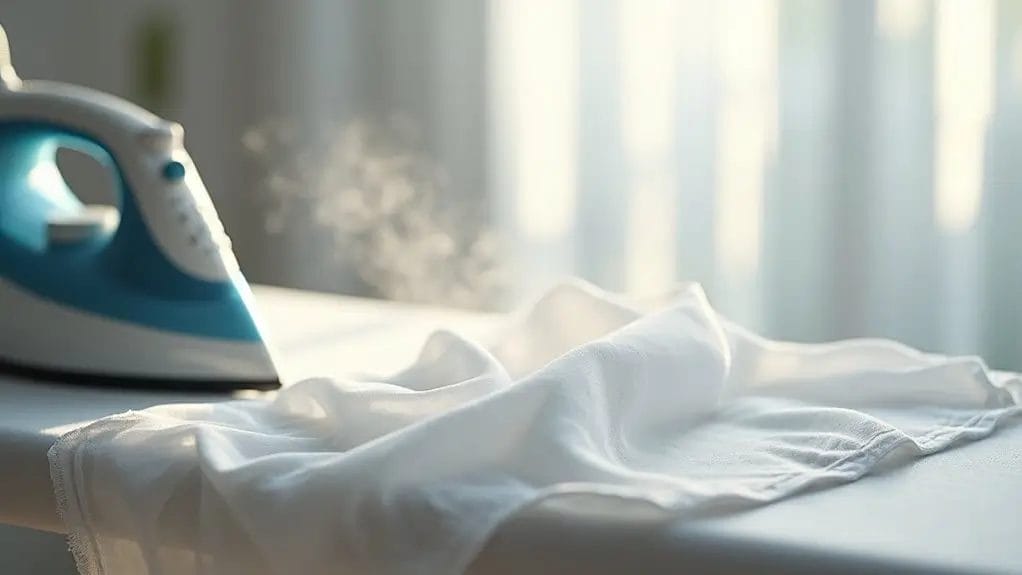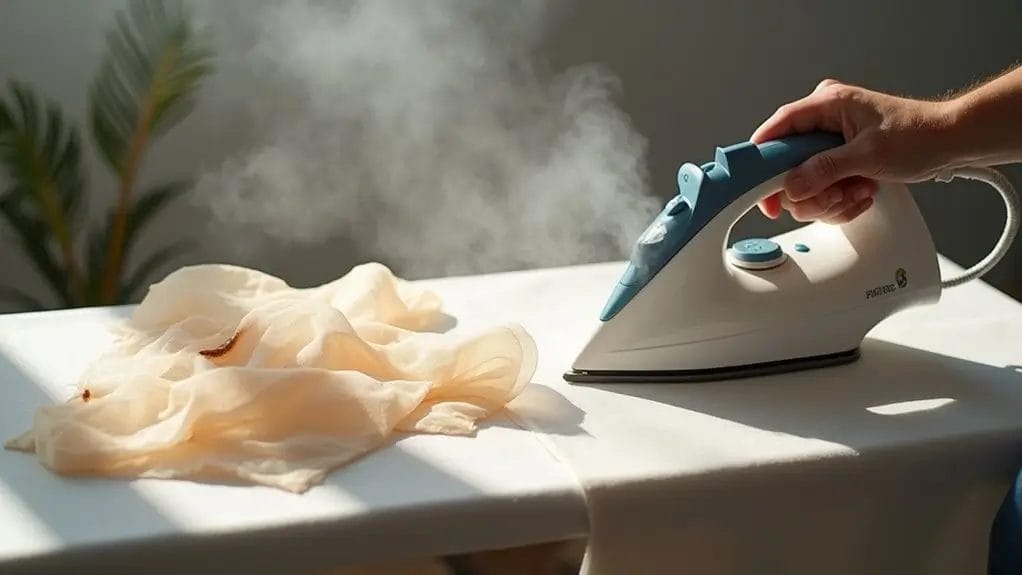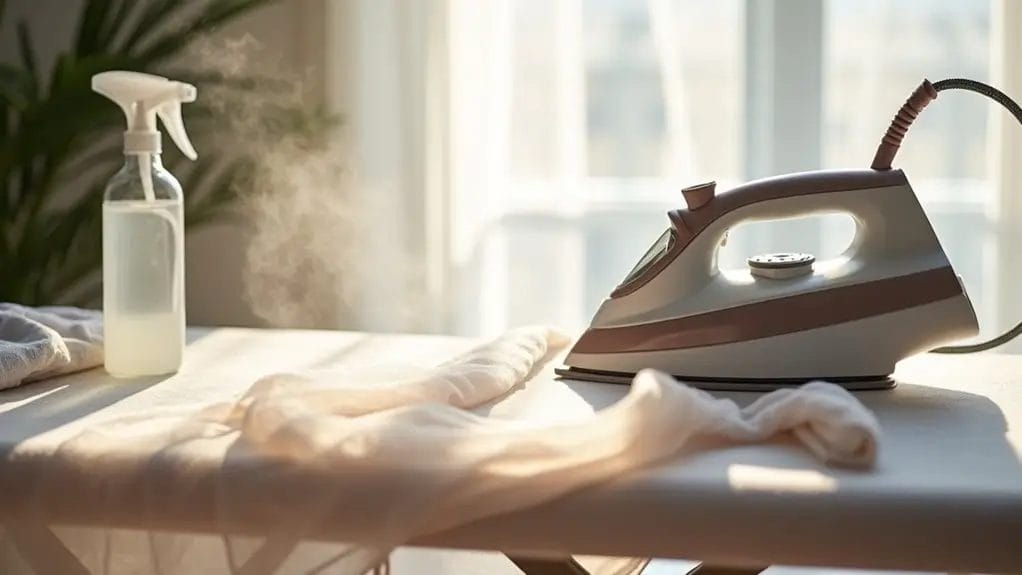Can you iron chiffon fabric? This question often comes up for anyone working with this delicate, lightweight material.
Chiffon is known for its sheer, flowing quality, but it also has a reputation for being tricky to handle, especially when ironing. Understanding how to iron chiffon is important to avoid damage like melting, burning, or unwanted wrinkles.
In this article, we’ll explore the safest techniques and tips for keeping your chiffon looking smooth and beautiful without causing harm.
Key Takeaways
- Yes, you can iron chiffon fabric using low heat settings around 250-300°F.
- Always place a thin pressing cloth between the iron and chiffon to prevent burns.
- Test the iron on a small, hidden area first to avoid damage.
- Use light, quick motions and avoid pressing hard to prevent stretching.
- Alternatively, use a handheld steamer to remove wrinkles without direct heat.
Understanding Chiffon Fabric and Its Properties

First, let’s talk about chiffon fabric and what makes it unique for ironing.
What Is Chiffon Fabric?
Let’s dive into what chiffon fabric really is. You’ve likely seen this lightweight, sheer fabric in wedding dresses or elegant scarves. As a delicate fabric, chiffon needs gentle care to avoid damage.
Chiffon comes in types like silk chiffon, which is super soft and luxurious, and polyester chiffon, which is more durable and affordable. Both share an open weave, making them prone to snags.
Think of a wedding veil or a breezy summer top—that’s chiffon’s charm.
Knowing this helps you handle it right. Whether it’s a gown or scarf, you’ll protect its beauty with proper care.
Chiffon Texture and Feel
Ever wondered what makes chiffon fabric so unique to touch? It's all about the lightweight fabric and its special weave.
The highly twisted fiber creates a sheer, flowing look that's soft and airy, perfect for elegant outfits.
Delicate chiffon feels almost weightless, yet it’s tricky to handle.
You’ll notice this texture in dresses or scarves, often made from synthetic blends like polyester.
The loose weave adds to its breezy charm but demands care.
Heat Sensitivity of Chiffon
While chiffon fabric looks stunning, its heat sensitivity demands careful attention during care and maintenance. Chiffon can melt under high temperatures, so you’ve got to use low heat when ironing. Stick to the lowest heat setting on your iron to avoid damage and protect the fabric.
This delicate material cannot handle much heat, or you will damage the fabric permanently. For example, ironing a chiffon dress on a high setting might cause shiny spots or holes.
Always test a small, hidden area first. By keeping heat minimal, you make sure your chiffon stays beautiful for special occasions or everyday wear.
Risks of Ironing Chiffon and Common Mistakes

When ironing chiffon, you must be aware of serious risks, such as heat damage or burns.
Stick around to learn how to avoid these common slip-ups with the right settings and techniques!
Heat Damage Concerns
Chiffon is a lightweight and delicate material, so too much heat can ruin it fast. If you don’t use low heat, you risk warping or melting the fabric.
Always use the lowest heat setting to protect it.
Avoid common mistakes like cranking up the temperature for speed.
Test on a hidden spot first; a ruined hem isn’t worth the rush.
Don’t leave the iron sitting too long either.
These errors can weaken chiffon, making your favorite dress unwearable in seconds.
Fabric Burn Risks
How can you avoid burning chiffon when ironing? The delicate nature of chiffon makes it prone to damage, so caution is key.
Always use a low heat setting on your iron, as high temperatures can scorch this sheer fabric instantly.
Don’t skip using a pressing cloth; it’s a barrier that keeps things safe for chiffon.
This way, you’ll keep your garment flawless and intact.
Wrinkling During Pressing
As you start ironing chiffon, you might notice new wrinkles forming during the process. This wrinkle issue, often called chiffon wrinkles, happens when you press too hard or move the iron unevenly. It’s frustrating to see stubborn wrinkles appear as you’re trying to smooth out wrinkles!
Check this table for quick tips to avoid getting wrinkles out of a chiffon the wrong way. Don’t create more wrinkles with an iron by rushing.
| Mistake | Why It Happens | How to Fix It |
|---|---|---|
| Pressing too hard | Adds new wrinkles | Use light pressure |
| Uneven iron movement | Creates stubborn wrinkles | Glide smoothly |
| No pressing cloth | Causes chiffon wrinkles | Always use a barrier |
| Over-ironing | Worsens wrinkle marks | Limit time per spot |
| Wrong technique | Fails to smooth out wrinkles | Lift iron between passes |
Incorrect Temperature Settings
Imagine this: you're excited to iron your chiffon dress, but the iron's heat is way too high. Disaster strikes!
Chiffon requires low heat, around 250-300°F, to avoid melting or scorching. A too-hot iron can burn holes or create shiny spots.
For example, test on a hidden area first. If it’s too hot, dial it down. Also, try gentle steam from a distance to smooth wrinkles.
Overpressing Delicate Material
While ironing chiffon, overpressing delicate material can quickly lead to irreversible damage. If you linger too long, you risk burning or melting it.
When ironing this delicate fabric, always keep the iron moving. Don’t press hard or stay in one spot; that’s a common mistake.
For example, hovering over a sleeve for 20 seconds might leave a shiny mark or hole.
Mastering the art of ironing means light, quick motions.
Protect this delicate material, and you’ll keep your chiffon looking flawless for any occasion.
Can You Iron Chiffon Fabric? A Step-by-Step Guide

Now, let’s get started on ironing your chiffon fabric with a clear step-by-step approach.
Step 1: Prepare Your Ironing Tools
Gather your ironing tools to guarantee a smooth process when working with delicate chiffon fabric. Ensure tools are spotless to avoid marks on your fabric. Check out this table for tool purposes:
| Tool | Purpose | Why It Matters |
|---|---|---|
| Iron | Smooth wrinkles | Prevents fabric damage |
| Pressing Cloth | Protects chiffon | Avoids shine or burns |
| Spray Bottle | Adds light moisture | Eases stubborn creases |
Prepare well, and you’re set for success!
Step 2: Set the Correct Temperature Level
Three key steps can guide you in setting the correct temperature for ironing chiffon without risking damage.
First, check the care label to identify the type, like synthetic chiffon or silk chiffon. Different types of chiffon, including nylon or polyester chiffon, need specific heat levels.
Next, set your iron to the lowest setting, often labeled “silk or “synthetic. Test it on a small, hidden area to avoid burns.
Finally, avoid direct steam; it can spot delicate fabrics.
This guarantees you smooth wrinkles from chiffon safely, keeping it looking flawless every time.
Step 3: Use a Protective Cloth
After setting the right temperature, let’s move to the next essential step: using a protective cloth. This barrier, like a thin cotton sheet, shields your delicate chiffon dress or garment from direct heat. It prevents burns and shiny marks that can ruin the fabric.
Place the cloth over your chiffon before ironing to smooth out any creases. This method safely removes wrinkles from your chiffon, ensuring effective wrinkle removal.
Always cover the entire area to protect the fabric from re-wrinkling. Trust me, this simple trick keeps your chiffon looking flawless every time!
Step 4: Iron With Gentle Pressure
While you’ve set up your protective cloth, it’s time to focus on ironing chiffon with gentle pressure for the best results.
Start by making light, smooth strokes over the cloth. Iron for just 10 seconds per spot to remove wrinkles without harming the fabric, as chiffon can't handle high heat.
Aim for the entire dress to be wrinkle-free by working section by section.
After ironing, hang your chiffon immediately instead of folding your dress. This’ll keep your chiffon smooth and ready for any occasion.
Alternative Ways to Care for Chiffon Garments
Caring for chiffon garments doesn’t always mean pulling out the iron. You’ve got other ways to keep them looking great. Let’s explore some easy, safe methods to maintain that delicate fabric. Try these alternatives to smooth out wrinkles:
- Hang in a Steamy Bathroom - Let steam from a hot shower relax creases.
- Use a Handheld Steamer - Gently steam from a distance.
- Lay Flat with Weights - Place light objects on the edges overnight.
- Store Properly - Fold loosely to avoid creases.
These tricks help you care for chiffon without heat damage.
Final Words
Ironing chiffon fabric is totally doable with the right care, keeping its delicate, sheer look intact. Use a low heat setting, a pressing cloth, and gentle glides to avoid burns, like when smoothing a favorite scarf.
These steps guarantee your chiffon dresses or tops stay wrinkle-free and stunning for any occasion, from school events to family gatherings, helping you look polished effortlessly.
Learn more fabric knowledge on the Longan Craft Blog, and dive into the fabric world with Longan Craft!
FAQs
Can Chiffon Be Ironed on a High Heat Setting?
Don’t iron chiffon on a high heat setting! You’ll risk melting or damaging this delicate fabric. Stick to a low heat, around 250-300°F, and use a pressing cloth for safe, effective results.
Is Dry Cleaning Necessary Before Ironing Chiffon?
It’s not always necessary, but if it’s stained or oily, clean it first. This will avoid setting marks into the fabric with heat. Take care!
How Often Should Chiffon Garments Be Ironed?
Don't overdo it—iron only when wrinkles are noticeable. Frequent ironing can stress delicate fabrics, so handle them with care and store them properly instead.
Can Chiffon Be Ironed Without a Pressing Cloth?
You shouldn't, as chiffon's delicate nature risks scorching or leaving shine marks. Always use a barrier to protect the fabric, ensuring you don't damage it.
Does Ironing Chiffon Affect Its Color or Texture?
It can, if you're not careful. Use low heat and a pressing cloth; otherwise, you might dull the color or damage the delicate weave.


0 comments